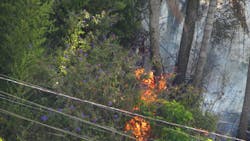Mitigating Wildfire Risk with Transmission Technology
We’ve all seen the impact of wildfires on California utilities, with devastating impact on Pacific Gas and Electric (PG&E) customers and shareholders.
What can utilities do to proactively address this risk and make sure that the modern grid is safe for customers and shareholders alike? Yes, development of microgrids, distributed energy resources (DERs) and energy storage is vital to building a flexible, safe grid for the 21st century. But the reality is this: transmission lines are still delivering the lion's share of electricity consumed in the United States. That equates to hundreds of billions of dollars in value being delivered across transmission infrastructure. That won’t change overnight, and utilities need to assess their options to ensure that their transmission lines are being operated as safely as possible today, in 2019. With the impact of climate-related wildfires showing no signs of slowing down, utilities must act quickly to identify and mitigate the risk they are carrying.
So, what options do utilities have?
One option is system hardening, which generally involves rebuilding lines to more stringent safety standards, raising the height of towers, and widening right-of-ways to reduce the risk of vegetation encroachment. Such line hardening makes sense in high-risk areas, but is very costly, and often encounters intense local opposition. And system hardening doesn’t address the immediate question of how to alleviate wildfire risk in the short term.
Undergrounding transmission lines is an extreme form of hardening and is highly effective at preventing risk of wildfires from power lines. But the cost of undergrounding lines is even higher than rebuilding overhead lines, with one mile of new line costing US$1.4 million to US$30 million, depending on geography, population density and voltage level. Undergrounding may be appropriate in specific sections where safety risk is highest, but it is not a financially viable strategy for addressing wildfire comprehensively.
Second, utilities can enhance current weather modeling and wildfire risk monitoring. In December, a month after the Camp Fire, PG&E announced that it would expand its Community Wildfire Safety Program (CWSP), which includes expanded detailed inspection of more than 5,500 miles of transmission lines, increased aerial inspection from drones and helicopters, and using advanced weather sensors to improve forecasting. These efforts can play an important role by more precisely identifying when and where wildfire ignition risks are greatest, but don’t enhance visibility on the condition or safety of the lines themselves.
Third, and perhaps most promising, is the use of advanced sensor and analytics technologies to improve situational awareness and anomaly detection. Recent advances in line monitoring technologies have advanced capabilities and reduced costs to the point where it is hard to justify not deploying these to enhance the safety of the grid.
Utilities are starting to see the value in these technologies. In October, San Diego Gas & Electric announced the rollout of an innovative line break protection system. This system uses synchrophasors which measure power and its phase up to 60 times per second - 120 times more frequently than other available industrial controls - and connects with smart relays to shut down broken power lines before they hit the ground, reducing fire risk.
Optical sensors that can be mounted to the power line tower structures are also readily available now. This technology has advanced to the point where they no longer even need direct contact with the conductor. These sensors precisely track each individual conductor’s position and can detect anomalies which may indicate risk to asset health or public safety. Alerts can be sent to operators if a conductor becomes too hot or sags below its safe operational clearance limit, preventing possible contact with vegetation undergrowth.
When the data from the optical sensors is examined with advanced analytics, operators are able to learn when their conductors have experienced a loss of tensile strength or have had damage to their supporting hardware or structures, which could lead to unplanned equipment failure.
Utilities have successfully deployed sensors in other areas of their networks and benefitted from enhanced visibility on asset health and improved public safety. For example, the widespread deployment of substation transformer monitoring has improved ability to forecast failures and perform condition-based asset management. They can now do the same for transmission infrastructure.
Adoption of these technologies will ultimately provide a win-win-win. Regulators should have little difficulty supporting rollout because of the compelling cost/benefit ratio. The real-time and historical data these systems provide will protect shareholders and other stakeholders internal to the utility from liability risk by confirming lines are operated safely. And with better alerts and visibility into the operation of lines, it will protect the public, who bear the most immediate costs of wildfires.
The recent events in Northern California should serve as a cautionary tale for the industry and a wake-up call for utilities to proactively develop plans to improve the safety of their grids. There is no single magic bullet for utilities to solve the challenge of increasing wildfire risk, but proven solutions exist. Selective asset hardening and undergrounding, enhanced weather modeling and wide deployment of advanced sensors all play important roles. Together, these strategies can contribute to dramatically reducing the risk of wildfires and improving grid safety, protecting the public and utility stakeholders alike.
About the Author
Hudson Gilmer
Hudson Gilmer is a CEO of LineVision.
